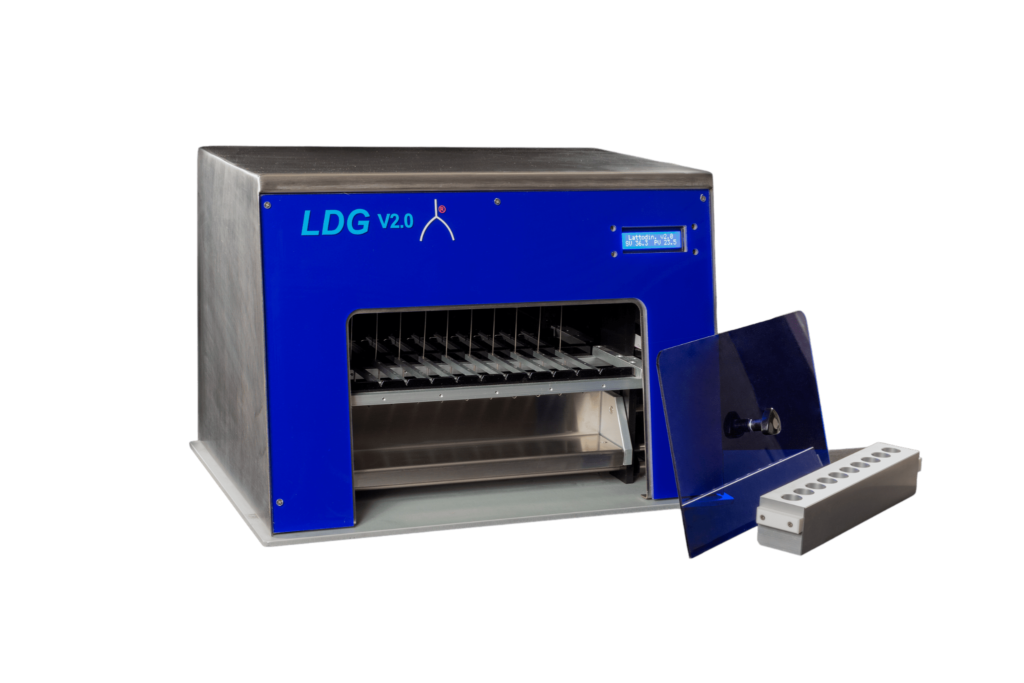LATTODINAMOGRAFO
The Lattodinamografo is a modular instrument born from the need to be able to automatically record the coagulation properties of the milk intended for cheesemaking.
The MAPE System for the dairy industry, in Italy and around the world!
ABOUT US
The lactodynamograph: what is it?
Lattodinamografo is a modular instrument that automatically records milk coagulation properties: it measures milk coagulation acceptance.
The first prototype is more than 20 years old, but the latest version reworked with advanced electronic components is from 2019/2020.
The device can measure the milk coagulation time (K20) (presamic coagulation, with rennet added, or acid) of all mammals, such as cows, sheep, goats, buffaloes, and, at the same time, the clot consistency (r) and coagulation progress (A30). The trend of the different stages of coagulation is measured and recorded through a semi-invasive system that returns an easy-to-read thromboelastogram.
The challenges of dairy farms
Raw materials are becoming more and more expensive, the feeling of instability is growing among consumers, and the foreign market is constantly looking for Italian quality.
The dairy sector has only one way to overcome these challenges: seeking the highest quality by optimizing production with timely technical and strategic choices.
How is quality cheese produced?
How is quality mozzarella cheese produced?
Pecorino, buffalo, gorgonzola? Parmesan cheese?
All of them are milk derivatives, so it all starts with milk and its manufacture.
Analysis of milk properties for dairy
We carefully select that milk meant for a specific cheese product in order to achieve the highest possible quality. In this way, dairy farms will know for which type of cheese that type of milk is most correct.
The goal is to increase the value of milk production by targeting it to the most appropriate processing, to the type of product best suited for the characteristics of a specific milk production.
HARDWARE
Service Module
Necessary for heating milk samples placed in ten-place aluminum racks. Once the set temperature for the analysis has been reached, the pre-set quantity of rennet is added, the rack is transferred to the analysis module, where small steel pendulums highlight the start of milk coagulation through oscillating movements.
Analysis module
All movements, duly detected and amplified, are memorized and allow the typical "coagulation bell" to be displayed, accompanied by all that series of useful information for correct classification.

Why does the lattodinamografo set the quality of the dairy product?
Estimate the dairy suitability of milk
The only device worldwide for this type of data
Analysis time
Minimal periodic maintenance
Industry 4.0 production model
explore the map
OUR INSTALLATIONS
LACTODYNAMOGRAPH
SYSTEM MANAGEMENT
It consists of a service module and an analysis module: all instruments are unique, checked during design and assembly by MAPE System’s mechanical engineers.
The service module is a heating plate that is necessary for heating milk samples. These are placed in 10-place oxidized aluminum racks, and once the set temperature for analysis is reached (about 35/36 degrees), the predetermined amount of rennet is added, depending on the type of milk (cow, sheep, goat, etc.).
The rack is then transferred to the analysis module, where small steel swings highlight the beginning of milk coagulation through oscillating movements: the milk, in fact, begins to coagulate through harmonic movements.
This sign properly detected and amplified, is gradually stored , allowing the visualization of the typical bell of coagulation together with all those information useful for its correct classification.
The device is fully capable of being programmed for all the functions you want; the instruments, up to a maximum of four, can be used in series and followed simultaneously by a single PC.
The lactodynamograph records data and useful reports in order to identify the type of milk and its dairy aptitude.
- Ability to check one or more samples of milk (cow, sheep, goat, buffalo) and curd.
- Direct control of the initial coagulation time, curd formation rate and curd density.
- Easy variation of temperature and amount of rennet for development of new methods or simulation of different processing.
- Automatic storage of “coagulation bells” and related classification of milk samples, according to pre-set tables.
- Ability to include other information and other analytical data regarding the sample under investigation.
- Equalization of graphs by individual calibration of small pendulums
The lactodynamograph in the world!
+39 055 669843
+39 055 0332828
+39 334 1857021 (also Whatsapp and Telegram)
From Monday to Friday: 8 AM / 1 AM – 2 PM / 5 PM
